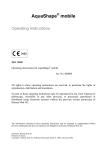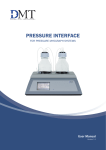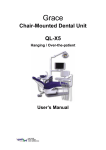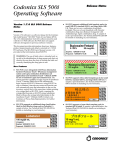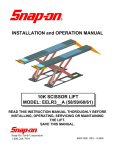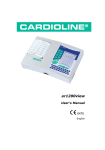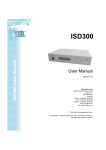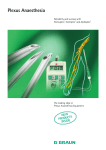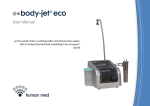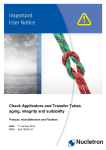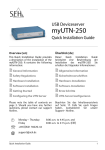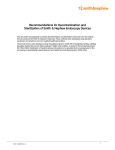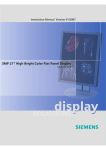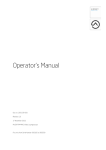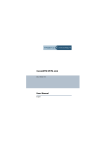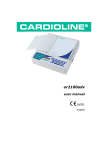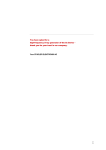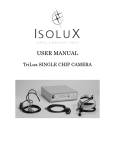Download Operating Instructions
Transcript
Operating Instructions ISO 13485 Operating instructions for body-jet Art. No. 500000 Art. No. 500000-1 Art. No. 500000-2 All rights to these operating instructions are reserved, in particular the rights of reproduction, distribution and translation. No part of these operating instructions may be reproduced in any form whatsoever (photocopy, microfilm or any other process), or processed, reproduced or distributed using electronic systems without the previous written permission of human med AG. The information contained in these operating instructions may be amended or supplemented without previous notification and does not represent any obligation on the part of Human Med AG. Printed by: Human Med AG Printed in Germany Copyright © Human Med AG; Wilhelm-Hennemann-Straße 9, 19061 Schwerin; 200/ Table of Contents Title General description of the body-jet Page 2 Safety Information and Measures Safety notations Importance of the User Manual Electrical safety Safety instructions for the use of body-jet Operational safety Safety measures 3 3 4 5 5 5 Control Elements and Symbols 6 Description of applicator-system and suction cannula 12 Working with the body-jet 1) Insertion of the pressure container 2) Inserting the suction bag and connecting the suction hose 3) Connecting the applicator system to the liquid bags 4) Attachment of the suctio n cannula 5) Starting up the pressure generation and suction units 6) Operation 7) End of the operation 13 16 21 22 23 24 26 After the Operation 27 Installation of the body-jet 29 Environment Operation conditions Installation instructions Troubleshooting 31 Reprocessing the reusable suction cannulas 34 Maintenance, Customer Service, Warranty 36 Technical Data/ technical description 38 These operating instructions constitute a part of the body-jet device and must be kept in an easily accessible place in order that they may be consulted at any time by operating staff. Rev 11/2007 1 von 38 Description of the body-jet The body-jet device was specially developed for the field of aesthetic plastic surgery, and in particular, for liposuction (fat extraction). For this purpose the method of water-jet-assisted liposuction (WAL) was developed by our company in cooperation with experienced doctors in the field of aesthetic plastic surgery. In contrast to traditional methods in which the tumescence solution is introduced into the body and then removed by suction after a reaction time of up to one hour, the WAL method involves the sucking off of fat cells in parallel with their detachment by a water jet. The key feature of the method is the newly-developed applicator system. In terms of its construction and method of operation this new applicator is comparable to the helix hydro-jet applicator. 1. The liquid is transported from the container via the pressure generation unit through a capillary tube to a stainless steel capillary with a nozzle, which is introduced into the patient. 2. The pressure generation device produces a pulsating water jet at a pressure of up to 110 bar. This water jet escapes from the nozzle head of the nozzle capillary in the form of a flat angle fanned jet. 3. The stainless steel capillary is integrated into a hand piece. 4. An infiltration or suction cannula may be attached to this hand piece according to choice. 5. The water jet detaches the fat cells from the connective tissue. The fat cells and flushing solution are simultaneously sucked off by the suction cannula via the suction tube into the aspiration container. The suction process is achieved by an integrated suction system. Devices belonging to these construction series comply with the stipulations of Regulation 93/42/EWG as well as the German Medical Product Law. Certification of our company in accordance with DIN EN ISO 13485 as well as Appendix II of Regulation 93/42/EWG is a guarantee that all provisions of Regulation 93/42/EWG and the German Medical Product Law regarding the development, production, final control and marketing of body-jet devices and their accessories are complied with. Rev 11/2007 2 von 38 Safety Information and Measures Safety notations WARNING! The WARNING! safety indication refers to a risk of personal injury. CAUTION! The CAUTION! safety indication refers to a risk of damage to property. ATTENTION: The ATTENTION! safety indication refers to a risk which can cause equipment to become unserviceable. Compliance with safety information Appropriate application of and compliance with the safety information makes a considerable contribution to the safety of the user, patients, and environment. Safety of equipment and instruments body-jet devices comply with all relevant and generally accepted engineering practices as well as with the applicable occupational protection and accident prevention regulations. Contribution of medical personnel to safety Working with medical equipment is basically associated with certain risks to medical personnel and patients. Risks cannot be entirely eliminated by design measures alone. Safety does not depend solely on the equipment but depends to a large extent on factors influenced by you. These factors are dealt with in the safety information in this chapter. Safety and equipment use This User Manual is an integral part of the body-jet. All users should be familiar with the instructions in the Manual. Maintain these instructions in the Manual. Maintain these instructions in a secure but readily accessible location so that all users may reference it at any time.Prior to using the system, reference published literature and/or perform trial test to establish pressure settings for applications. Importance of the User Manual and training of medical personnel Who should read this User Manual? The User Manual forms an important part of the safety concept of the unit. Therefore everyone who is concerned with • preparing, • adjusting, • operating, • disassembling, as well as • cleaning and disinfecting the unit ( including other associated equipment ) and instruments as applicable should read the User Manual and the instructions for using the instruments. Please pay partic ular attention to the safety instructions in each chapter. Rev 11/2007 3 von 38 Training WARNING! The equipment must be used only by medical professionals who have been appropriately trained (In-Serviced) by human med . Training must be carried out only by personnel who are suitable on the basis of their knowledge and practical experience. Human med is not responsible for damage caused by user error. In the event of uncertainties or if you have any questions, please contact human med. We will be glad to give you further assistance and will be pleased to receive your suggestions concerning this User Manual. Electrical safety and electromagnetic compatibility The device must be connected to an earthed mains supply in accordance with DIN VDE 0107. This device has been tested for immunity to interference and for electromagnetic compatibility by an accredited laboratory and the results lie within the limit values for medical electrical equipment as defined in standard IEC 60601-1-2: 2001. Provided this device is correctly installed and is functioning properly it is thus adequately immune to interference and cannot interfere with other devices. An exception to this is the interaction with HF surgical devices since these do not always comply with the limit values of standard IEC 60601-1-2. When using the body-jet device in conjunction with HF surgical appliances manufactured before 09.11.1992 a minimum distance of 2 m must be ensured between the body-jet and the HF surgical appliance as well as the HF surgical leads. When using the body-jet device in conjunction with HF surgical appliances or laser cutting devices it is essential that priority is given to the safety stipulations pertaining to these devices. Prevention of electric shock Leakage current The equipment conforms to the requirements of “Type BF applied part”. Power cord and power socket outlet WARNING! The supply voltage must be identical to the voltage stated on the nameplate. Connect the unit to a ground outlet. Use only the human med ag power cord or an equivalent power cord. Inspecting the equipment WARNING! Inspect the equipment ( the unit including detachable components such as cords/ cables and the foot pedal) for damage or being compromised after each use. Do not use damaged or compromised equipment. Please contact customer or technical service for replacement parts or servicing. For the safety of medical personnel and patients, never attempt repairs. Any modification to the equipment will invalidate liability on the part of human med. Rev 11/2007 4 von 38 Safety instructions for the use of body-jet It should be observed that the direct water jet may be dangerous due to its possible cutting action depending on the pressure setting. Damage may be inflicted on eyes and skin should they come into contact. The following general safety regulations must be strictly observed: - All persons operating the device must receive prior instruction and be acquainted with pressure and suction parameters. - The foot pedal must not be operated prior to use of the device. - When using the handpiece, care must be taken to ensure that the water jet is only directed towards the area being operated on. - The capillary tube must not be bent Operational safety: Initial operation of the device is only permitted by professional staff previously instructed by Human med ag. The device may only be used after: • • • ready-to-use delivery of the device by the service team of human med AG undertaking all safety measures, mastering functional procedures and operation of the device in the event of malfunctioning. All persons operating the device are fully responsible for observing all safety measures necessary to ensure that the patient, the doctor- in-charge and all other persons present are not exposed to danger during operation of the device. Safety features: Safe and reliable operation of the device is ensured by a series of built- in safety features. Pressure build-up is only possible after an audible click indicating correct insertion of the pressure container. The device is designed so as to eliminate serious operational errors. The disposable applicators are designed in such a way that resterilization is not possible. A non-return valve shuts off the liquid flow when the foot pedal is not activated. Contraindications: The Body-jet , the WAL applicator system and the body-jet cannulas are not approved for intracardial use. The operating instructions contain additional important information which should be observed when operating the body-jet device. Rev 11/2007 5 von 38 Control Elements and Symbols Control elements of the membrane keypad (1) Vacuum-manometer The selected suction pressure is shown on the manometer (2) Memory -display of the weighing- system The display indicates the total liquid consumption of liquid used ( See page 16 and 17 ) (3) Display shows the amount of liquid used during the current suction sequence ( See page 16 and 17 ) (4) MEM –button in order to activate the weighing-system ( See page 16 and 17 ) (5) VACUUM-button The suction unit is turned on and off using the button (6) STOP-button is for emergency stop (7) Display The preselected pressure range is shown in this display. (8) + and – button Select the pressure range ( RANGE 1 to 5 ) using the buttons (9) The pressure generation unit is activated by pressing this ON/OFF button (10) PUMP button to removel the pressure container ( See Page 18 ) Rev 11/2007 6 von 38 Control elements at the front, on the left and to the right (1) socket for the pressure container 1 (2) suction connector (see page 12) to connecting the vakuum hose 2 3 5 5 4 6 6 (3) Sealing cap to the sealing the pressure container socket (4) rotary switch The desired suction pressure may be selected by means of this rotary switch. (5) vacuum hose together with an angular connecting piece and plug connector For connecting from suction container to the suction connector of the body-jet (6) Suction container a suction bag must be inserted in each suction container Rev 11/2007 7 von 38 (7) suction bag with angle connector Manufacturer Serres Oy, FIN 7 Control elements on the back of the device 2 1 3 (1) body-jet power switch On / Off. (2) Connection for the weighing system The weighing system measures the liquid consumption during the operation. Rev 11/2007 8 von 38 (3) Type label with the following symbols and their significance Note symbol This symbol indicates that the operating instructions and other relevant instructions must be read before the device is put into operation. This symbol indicates that the device has an application section of type BF and fulfils the applicable safety requirements of IEC 60601-1. This symbol indicates that the date of manufacture of the device is shown here. This symbol indicates that the product conforms to the specifications of European Directive 93/42/EEC for medical products and that the manufacturer operates a quality assurance system monitored by certification agency number 0482. Rev 11/2007 9 von 38 4 5 (4) Symbol for handling the device during transport ATTENTION! The device must not be transported outside the OP area with liquid bags attached. (5) Suspension facility for the liquid bags (with integrated weighing system) ATTENTION! Maximum volume of the bags on the suspension facility: 7000 ml in total (6) Removable rack with the bag suspension facility ATTENTION! The connector for the weighing system must be unscrewed before removing the rack 6 Rev 11/2007 10 von 38 7 8 7 8 9 (7) Symbol for foot-switch connection This symbol indicates that only a foot switch may be connected at the connection marked with this symbol. ATTENTION! Only the supplied foot switches MGF 1Ö/1S-MED-AP from Steute Medizintechnik may be connected. (8) Foot-switch connection The foot switches connected here are used for activating the set water pressure. (9) Power connection Connect the body-jet to a correctly installed grounded contact socket outlet using only the original powercable or equivalent power cable. The power cable must bear the national test symbol. (10) Foot-switch holder Place the foot-switch in the pedal holder when transporting or shutting down the body-jet. 10 10 Rev 11/2007 11 von 38 Sterile single-use WAL applicator system F (A) Hand-piece with the jet capillary tube for introducing the liquid for the detachment of fat cells. Also deployable as a filtration cannula D E C (B) Transfer set with two supply lines for the simultaneous connection of two liquid bags B A (C) Pressure container with a piston for generating the preselected liquid pressure for optimum detachment of fat cells (D) PA tube for transporting the pressurized liquid to the jet capillary (E) Tube clamp for the liquid bag supply lines (F) Puncture cannula with a protection cap attached to the liquid bag supply lines Hand-pieces with suction cannula B A (A) Suction cannulas are available with a wide variety of suction hole arrangements (see product range) (B) Bypass hole for activating and terminating the suction procedure by closing and opening the hole Rev 11/2007 12 von 38 Working with the body-jet 1. Insertion of the pressure container A) Remove the applicator system from the sterile package. Only use applicators from undamaged packages! Remove the sealing cap from the pressure container socket by turning it in the anticlockwise direction. Insert the pressure container in the socket provided. 1 CAUTION: The pressure line (rigid PA tube,1) must point upwards whereas the suction lines (flexible PVC tube,2) must point downwards. 2 B) Bring the pressure container from the park position into the operating position by applying slight pressure on the pressure container with the ball of the thumb. Rev 11/2007 13 von 38 C) The pressure container is then engaged by applying gentle pressure with the thumb. CAUTION: If the pressure container is not correctly engaged, it is not possible to build-up pressure! D) Now screw on the sealing cap hand-tight in the clockwise direction. Rev 11/2007 14 von 38 2) Insertion of the suction bag and connection of the suction tube Two suction containers of identical design and mode of operation are provided on the left and right- hand side of the body-jet device for accepting suction bags. CAUTION: Each suction container (A) must be connected to the suction connector (G) located on the respective side of the device via an angular connecting piece (E), a suction tube with an Overflow Protection (D) and a plug connector (F). The required suction tubes together with an Overflow Protection, an angular connecting piece and plug connector are supplied with the device. C D G F E K B A B REMARK: The suction container are only intended for use with suction bags. The proper function of the suction by the body-jet can only be guaranteed , when 3000 ml suction bags with an angular connecting piece manufactured by SERRES OY,FIN are used. These may be obtained from human med or other supplier. CAUTION! Don’t connect the suction-tube of the WAL-applicator into the suction connector(G)! Ø A suction bag must be inserted in each suction container: A) Unfold the suction bag and place it into the suction container. B) Turn on the vacuum-pump. Rev 11/2007 15 von 38 C) Insert the lid of the suction bag by using vacuum, close the angle connector(K) with your finger and simultaneously push the suction bag lightly from the middle of the lid. The lid of the suction bag must be flushly seated in the suction container without leakage. D) Turn off the vacuum-pump. CAUTION! As both suction containers function in parallel it is necessary to close off the suction tube connector at the patient (C) end attached to one of the suction bags by means of a sealing cap (L). For this purpose it is first necessary to remove the angle connector (K) from one of the two suction bags in use. L K The sealing cap (L) must then be pressed into the opening of the patient connector (C). L L C Rev 11/2007 16 von 38 Ø Turn on the vacuum-pump. Check that the desired vacuum is established and the bag is fully inflated by closing the angle connector of the unsealed suction bag. Ø The suction tube (M) of the body-jet WAL applicator system must be firmly pushed onto the angle connector (K) of the unsealed suction bag. M K The suction system is now ready for use. Rev 11/2007 17 von 38 Ø Connecting the applicator system to the second suction bag: Each suction bag is fitted with an integrated overflow valve which interrupts the suction procedure when the suction bag is full. For this reason the applicator system should be connected up to the suction bag in the second aspirator in good time. Before doing so, the filled suction bag must first be sealed. M K C • Pull off the suction tube M with the angle connector (K) of the full suction bag. • Seal off the patient connector (C) using the sealing cap L as already described under 1. . Remove the sealing cap (L) from the suction bag of the second suction container and insert the angle connecor (K) in the suction tube of the WAL-applicator in the patient opening (C) of the suction bag. L C Rev 11/2007 M K C 18 von 38 Ø Removal and replacement of the suction bag If both suction bags become full of liquid during an operation, it is necessary to replace one or both suction bags. • • • Pull off the suction tube (M) with the angle connector (K) from the PATIENT conector of full suction bag. Close off the patient connector by means of the sealing cap L as already described under 1. Remove the suction bag from the aspirator using the grip N. M L • K C N Insert a new suction bag as described under 1. Ø Disposal of the filled suction bags CAUTION! The liquid suctioned off may contain germs harmful to the health. The filled suction bags including the suctioned off liquid must be disposed of strictly in accordance with the statutory hygiene regulations. The bags must be discarded in secure waste containers for infectious waste marked as hazardous waste. Details can be found in the hygiene plan of the hospital concerned. Rev 11/2007 19 von 38 3. Connecting the applicator system to the liquid bags A) The liquid containers must be hung on the rack, one container per hook. CAUTION: maximum container weight = 3500 g If bottles or canisters are used, these must be properly vented. (insert a vent cannula) We recommend the use of liquid bags only. B) The applicator system is connected to the liquid bags via the transfer set. One delivery tube (a) must be closed using the tube clamp. a Remove the protection cap from the puncture spike of delivery tube (b) and insert the spike cannula in the liquid container to be used first. b a Rev 11/2007 20 von 38 Open the tube clamp on delivery tube (a) in order to vent the tube system. b a As soon as the delivery tube "a" is completely filled with liquid the delivery tube is again closed using the tube clamp. The delivery tube "a" may now be inserted into the second liquid container, if available. First remove the protection cap from the puncture cannula. b a c c By opening and closing the tube clamps it is possible to select the liquid bag intended for treatment. 4) Attachment of the suction cannula B A Attach the suction cannula (A) required for the particular application to the jet handpiece (B). Caution! The supplied cannulas are sterile! Rev 11/2007 Recommendation: apply silicon spray to the inside of the cannula (A) attachment before use. This is necessary to assemble the cannula to the hand-piece (B) of the WAL applicator system. 21 von 38 4. Starting up the pressure generation and suction units A) Turn on the body-jet device by pressing the mains rocker switch on the back of the device. B) The pressure generation unit is activated by pressing the ON/OFF switch on the PRESSURE control panel The green LED flashes C) Select the pressure range ( RANGE 1 to 5 ) using the +/- buttons. The preselected pressure range is shown in the lefthand display. Rev 11/2007 22 von 38 D) The suction unit is turned on and off using the ON/OFF VACUUM button. The desired suction pressure may be selected in the range of 0 to minus 800 mbar by means of the rotary switch (1) on the front of the device. 1 The selected suction pressure is shown on the manometer. Rev 11/2007 23 von 38 E) In the event of a fault the suction and pressure generation units may be switched to EMERGENCY STOP using the STOP button. CAUTION! Reactivation of the device after EMERGENCY STOP is only possible by pressing the power switch on the back of the device. 6. Operation Following a prick incision the suction cannula is inserted in the skin opening to the fatty tissue to be extracted. By actuating one of the two foot switches the pressure generation unit is started and the water jet necessary to detach the fat cells is generated. The required suction is realized by opening and closing the bypass opening in the suction cannula handpiece. The liquid consumption during the operation is shown in the lower right-hand display. In order to activate this display it is necessary to press the MEM button prior to the operation. Rev 11/2007 24 von 38 By pressing and quickly releasing the MEM button once, the lower right-hand display is reset to ZERO. The liquid consumption so far is stored as a memory value and indicated in the right-hand upper display. This procedure may be repeated as often as required. The right-hand upper display then indicates the total liquid consumption whereas the right-hand lower display always shows the amount of liquid used during the current suction sequence. By pressing the MEM button for three seconds all consumption displays are reset to ZERO. This should always be done when connecting up new liquid containers during one and the same treatment. Rev 11/2007 25 von 38 7. End of the operation A) Switch off the pressure generation unit. B) Remove the sealing cap. C) Remove the pressure container by simultaneously pressing the unlo cking button EJECT PUMP . This procedure may take up to 5 seconds. D) Clamp the liquid delivery tubes and cut off the delivery system above the pressure container. E) Remove the resterilizable suction cannula handpiece from the jet handpiece. Rev 11/2007 26 von 38 After Operation 1. Discard the single-use applicator system ! CAUTION! The system may contain germs harmful to the health. The single -use applicator system must be disposed of strictly in accordance with the statutory hygiene regulations. Used systems must be discarded in locked waste containers for infectious waste marked as hazardous waste. Details can be found in the hygiene plan of the hospital concerned. 2. Switch off the body-jet 3. Cleaning and disinfection of the body-jet and accessories For cleaning and disinfecting the surfaces of the body-jet and accessories human med ag recommends wiping with disinfectant. Use only disinfectants that conform to the national standards of the particular country. Instructions for cleaning and disinfection Mix the disinfectant in the concentration specified by the manufacturer. Clean surfaces contaminated with blood with warm water before using the disinfectant, otherwise it may be less effective. Wipe the surfaces ensuring that they are uniformly treated. Comply with the action time of the disinfectant specified by the manufacturer. body-jet device Wipe the device with a soft cloth soaked in disinfectant. WARNING! Ensure that you disconnect the equipment or equipment trolley from the power supply before starting cleaning and disinfection. Unplug the power connector! ATTENTION Do not use substances containing solvents. WARNING! Moisture must not penetrate the equipment. Drain off any ingress of liquid immediately. The equipment must be used again only when this liquid has completely evaporated. sealing cap from the pressure container socket Wipe the sealing cap from the pressure container socket with a soft cloth soaked in disinfectant. If necessary use a soft brush soaked in disinfectant in addition. Refit the sealing cap on the container socket Foot-switch, cable for foot-switch and power supply cable Wipe the foot-switch, the foot-switch cable and the power supply cable with a cloth soaked in disinfectant. Rev 11/2007 27 von 38 4. Hang up the power cord and pedal in the positions provided. 5. Move the body -jet into its parking position. 6. Apply the wheel brakes. Inspecting the equipment and accessories WARNING! Inspect the equipment and the accessories (e.g. foot control, cable) for damage after every period of use. You must not use a damaged equipment, a damaged equipment trolley or damaged accessories. Exchange defective accessories. If the equipment or equipment trolley is damaged, please contact our customer service. For your safety and that of patients, never attempt to effect repairs yourself. Any modification will invalidate liability on the part of human med. Environmental conditions for transport and storage The body-jet device may be transported in the upright or lying position. Storage of the device has to be in upright position. Temperature - 30 °C to + 50 °C Relative atmospheric humidity 10 % to 95 % Rev 11/2007 28 von 38 Installation of the body-jet Environment Do not operate in explosion hazard areas WARNING! Only use the equipment in rooms used for medical purposes. Do not operate the equipment in an explosion hazard zone. For example the equipment should not be used in close proximity of flammable anaesthetics, combustible and/or explosive disinfectants, etc. Operating conditions ATTENTION: Only operate the equipment within the temperature and atmospheric ranges specified in Technical Data. If the stated tolerances are exceeded, the in-stalled equipment may not function properly or be damaged/unserviceable. Comply with all operating stipulations in Technical Data. Ventilation ATTENTION: Only use the equipment in an area in which air can freely circulate around the system housing. Do not use the equipment in confined spaces. Spillage of / Exposure to liquids ATTENTION: The equipment is not entirely resistant to the penetration of liquid. Therefore be careful not to spill liquids around or on the equipment. Power cord and power socket outlet WARNING! The supply voltage must be identical to the voltage stated on the name-plate. Connect the unit to a ground outlet. Use only the human med ag power cord or an equivalent power cord. • Verify that the power cord and outlet receptacle are properly insulated and intact. Be sure that the socket has three prongs. Do not connect the unit to the supply or use the unit if any defective conditions are present and the situation can not be appropriately corrected. • Route the power cord from the unit to the receptacle in such away so as to eliminate any dangerous situation (e.g., tripping). Installing the body-jet • Place/maintain the body-jet on a stable, horizontal, and vibration- free surface. • Direct sunlight on the unit should be avoided, in order to have adequate display legibility and for thermal reasons. • The back of the body-jet should be directed away from the operating field. • Upon establishing a good location for the unit (keep in mind the electrical supply need), engage the locking breaks on the rear wheels. Preparations for use The mains switch is located on the back of the device. Switching to „I“ turns on the device. Switching to "0" turns the device off. Rev 11/2007 29 von 38 Accessories / device combination: The body-jet device must only be operated using WAL-applicator systems and canulas supplied be the human med ag company. The currently valid accessory list shall apply. CAUTION! Only the accessory parts stipulated by human med ag in these operating instructions may be used for the body-jet. This applies in particular for the following accessories: • • • • Foot-switch with foot-switch cable Suction container Suction bag Vacuum tube with overflow protection, an angular connecting piece and a plug connector for connecting the suction container to the suction connection on the device • Sealing cap of the pressure container holder Any modification to the WAL applicator system, the cannulas or the device accessories will result in exclusion of liability by human med ag. It is permissible to connect the suction tube of the WAL applicator system to a different suction system. Other combinations of equipment are not permissible and will result in exclusion of liability by human med ag. Rev 11/2007 30 von 38 Troubleshooting in case of functional and operating faults This list is intended to help users to trace the causes of functional faults and to clear them as far as possible or to give more detailed information to the Service Department of human med AG. Fault Description No pressure build-up, no fluid comes out of the nozzle Possible cause of fault Instruction for elimination 1. The mains plug was not connected. 2. The power switch of the device was not “ON”. 3. The foot-switches were not Check the connectors. connected. 4. The “ON/OFF” button for „pressure“ was not activated. Activate the button „ON/OFF“. The LED-lamp next to „ON“ has to blink green. 5. The foot-switch was not pressed. Press the foot-switch. 6. The pressure container was not Please follow the routine described on pages 13 to 14 of this exactly inserted into the socked. operating manual. ATTENTION! You must check whether the piston of the pressure container is still in the park position or not. 7. The sealing cap was not screwed accordingly. Screw the sealing cap following the description on page 14. ATTENTION! The cap has not to be detached without counter-clockwise rotation. 8.Fluid was not connected. The puncture spikes of the Transfer set should be connected with the liquid bag. 9.The tube clamp of the Transfer set-supply line was not opened. 10.The air was not correctly removed from the Transfer set. Check the tube clamps and open the clamp of the fluid bag intended for use. Please check the connecting-routine for the applicator system described on pages 19 to 20. Despite checking all above mentioned items there is no water out of the applicator system after pressing the foot switch for 30 sec in RANGE 5. Rev 11/2007 Please replace the applicator system. 31 von 38 Fault Check / Clearance No power supply after operating the switch Power supply interrupted ðCheck mains plug ! Very weak jet, poor jet profile WAL applicator system blocked or faulty ðChange WAL applicator system Liquid on the floor under the device WAL applicator system blocked or faulty ðChange WAL applicator system No suction or only weak suction with the suction cannula Suction bag not inserted correctly, or second suction bag not closed, or suction tube not correctly attached ðCheck suction bag and suction tube Suction cannula blocked ðChange suction cannula The pressure container of the applicator cannot be removed in a way described on page 24 of this operating manual. - Generate a water jet in operation mode RANGE 5 for three seconds (see page 20 to 22) - deactivate the foot-switch - Twist off the sealing cap, activate the foot-switch again. - Switch off the pressure generation unit by pressing the ON/OFF button 9 on the body-jet display (see page 6 in this user manual). - Remove the pressure container by simultaneously pressing the unlocking button EJECT PUMP . This procedure may take up to 5 seconds. STOP fault message on the display and buzzer signal STOP 00 Triggered by activation of the EMERGENCY OFF button or the control pushbutton for overload on the power module. This fault message is also triggered by overloading of the geared motor. WAL applicator system blocked or faulty ðChange WAL applicator system STOP 01 Not activated. STOP 02 In event of non-compatibility of the nominal value stored in the software for the pressure of the device in range 0 (approaching the pump dead center point) Contact the responsible Technical Service. Rev 11/2007 32 von 38 STOP 03 In event of non-compatibility of the nominal value stored in the software for the pressure of the device in range 1 - 5. Contact the responsible Technical Service. STOP 04 In event of non-compatibility of the maximum voltage value for the device stored in the software in the range 1 – 5. Contact the responsible Technical Service. STOP 05 In event of non-compatibility of the maximum current value for the device stored in the software in the range 1 – 5. Contact the responsible Technical Service. STOP 06 Exceeding of the limit value of the specified voltage in the different ranges. Contact the responsible Technical Service. STOP 07 Exceeding of the limit value for the specified current in the different ranges. This resulted in overloading of the drive system. WAL applicator system blocked or faulty. First switch the device off and back on again via the main switch. If the fault message is displayed again ðChange WAL applicator system If the fault message is displayed once again contact the responsible Technical Service. CAUTION! In the event of malfunctioning, operation of the device must be immediately terminated by pressing the EMERGENCY OFF switch. The manufacturer human med AG Wilhelm- Hennemann-Strass 9 19061 Schwerin Tel.: +49 /(0)385 / 3957011 Fax.: +49/(0)385 / 3957010 must be notified of the fault. Rev 11/2007 33 von 38 Reprocessing the reusable suction cannulas ATTENTION! Instruments containing aluminium are damaged by strongly alkaline (pH > 10) cleansing agents or disinfectants. Only cleaning agents recommended for anodized aluminium should be used. Please consult the manufacturer of the instrument cleaning agent or disinfectant accordingly. At the end of this section we list a number of instrument cleansing agents and disinfectants tested by our company. WARNING! Cleaning and sterilization should only be carried out by trained staff in facilities specifically intended for this purpose. Restrictions regarding repeated cleansing: Frequent repeated cleansing has little effect on the suction cannulas. The product service life is normally governed by wear and tear resulting from use. Instructions: Place of use: Remove surface contamination using a disposable cloth / paper tissue. Storage and transport: Special care must be taken during transportation to ensure that the suction cannula nozzle is not damaged. It is recommended to reprocess the sucction cannulas immediately after use. Precleansing: Immerse in an enzymatic instrument cleaning solution (Helizyme, 1%, diluted with at most lukewarm deionized water, for at least 5 minutes or even longer in the case of persistent or dried contaminants). Clean the internal cannula walls using a pipette brush (Ø ca. 4 mm) followed by flushing of the cannula in the suction direction with deionized water and cleaning of the pipette brush also with deionized water to remove visible contaminants. Repeat this procedure until the flushing solution and the brush are free of visible contaminants. The instrument cleansing solution must be replaced at least once a day, and more often in the case of visible contamination. Cleaning: Fully immerse the suction cannulas in an instrument cleaning solution (Helizyme, 1%, diluted with at most lukewarm deionized water, for 5 minutes). Flush the suction cannula with instrument cleansing solution in the suction direction for 1 minute. Flush the suction cannula with deionized water in the suction direction for 1 minute. Disinfection: Fully immerse the suction cannulas in an instrument disinfectant solution (Stabimed, 2 %, diluted with deionized water, for 15 minutes). Flush the suction cannulas with sterile deionized water for 1 minute. Repeat the flushing procedure. The sterile deionized water must be replaced after each flushing procedure. Drying: Dry the suction cannulas internally and externally using sterile compressed air. Maintenance: Apply a small quantity of surgical lubricant spray to the attachment point of the suction cannula. Control and examination: Carry out a visible examination to check for damage and wear (firm seating of the suction tube in the hand-piece and intactness of the nozzle tip of the suction cannula). Packaging: The cannulas must be single packed in sterile packages in accordance with EN 868. The packages for the suction cannula must be sufficiently large to ensure that the package seal is not under tension. Sterilization: Steam sterilization by means of the fractional vacuum technique at 121°C (250°F) for at least 15 minutes has been validated. Sterilization up to 135°C (275°F) has been tested to not have any negative effects on the cannulas. Validation of your sterilization process with sterilization temperatures higher than 121°C (250°F) is necessary. WARNING! Check the sterilization protocol for compliance with the prescribed parameters. Storage: Store in a closed cupboard providing protection against dust and large humidity and temperature fluctuations. The shelf life is determined by the product specifications of the sterile packages used. Rev 11/2007 34 von 38 The instructions outlined above have been validated by the medical product manufacturer as being suitable for the preparation of the suction cannulas for reuse. The person responsible for cleansing is obliged to ensure that the cleansing actually carried out with the equipment, materials and staff deployed in the cleansing facility attains the desired results. As a guarantee of the latter, validation and routine monitoring of the procedure are normally necessary. It is equally important that any departure from the instructions provided must be carefully evaluated by the person responsible for cleansing with regard to their effectiveness and possible disadvantageous consequences. Table1: List of the DGHM-listed instrument cleansing agents and disinfectants tested with regard to material compatibility Trade name Manufacturer Instrument cleansing agent Helizyme BBRAUN Bodetex forte MucadontZYMAKTIV Instrument disinfection Stabimed Korsolex extra Mucocit T Disinfectant BODE Gigasept AF A 20 A 10 Rev 11/2007 MERZ BBRAUN BODE MERZ SCHÜLKE & MAYR OROCHEMIE OROCHEMIE Remarks enzymatic cleansing agent enzymatic cleansing agent aldehyde-free aldehyde-free aldehyde-free aldehyde-free 35 von 38 Maintenance, Customer Service, Warranty, Disposal Maintenance Authorized persons Safety inspections, modifications and repairs may be undertaken only by human med or by persons expressly authorized by human med AG. If unauthorized persons carry out modifications repairs, human med AG accepts no responsibility and claims under warranty become void. Safety inspections The safety inspection represents a preventative maintenance, in which an authorized technician checks whether the safety and serviceability of the equipment and the accessories are within a specific, technical specification. A safety inspection must be undertaken at least once a year. Modifications and repairs Modifications and repairs represent preventative maintenance. They must not impair the safety of the equipment or equipment trolley and accessories for the patient, user and the environment. This condition is met when changes to the structural and functional characteristics are not detrimental to safety. What safety checks must be undertaken? The following safety checks are specified for this equipment: • Equipment and accessories free from external damage. • User manual provided. • Inscriptions present and legible. • Ground wire tested according to EN 60601-1. • Leakage current measurement according to EN 60601-1. • Function testing of power switch, display, easy removal of the pressure container, suction, pressure stability, foot pedal • As part of the safety check the general condition of the drive unit must be checked with regard to wear. Wear of the crankshaft and the unlocking device must be assessed with particular care. • The results of these safety checks must be entered in the medical product book . If deficiencies are found during the safety checks which could endanger patients, personnel or third parties, the equipment must not be used until these deficiencies have been remedied by technical personnel. Periodic maintenance Maintenance is specified at least once a year. If maintenance is not carried out, errors can occur which may result in danger. The maintenance includes a safety check. Customer service If you are interested in a maintenance contract, please contact human med ag or an authorized distributor. Do you have any questions concerning the equipment or instructions for use? Would you like scientific publications from human med ag? If so, contact an human med ag. We will be glad to provide further assistance. Rev 11/2007 36 von 38 Warranty The device and accessories must be checked for defects and transport damage immediately after receipt. Claims for damages in this respect may only be asserted if the seller or transport company is notified without delay. A damage report must be drawn up. human med grants its customers a warranty for supplied body-jet devices in accordance with its General Terms and Conditions from the time of delivery and initial familiarization. A warranty over and above these conditions shall require the conclusion of a corresponding warranty contract. To do this, contact the seller of the device. The warranty covers the performance of any work that may arise in case of complaints relating to the function of the device if these are verifiably caused by the manufacturer. No warranty will be assumed for any faults arising due to wear and tear in use, incorrect use, technical interference with the device, deliberate damage or damage caused by gross negligence. Further claims, particularly claims for damages are excluded. Disposal The equipment can be disposed of at the end of their useful life as with normal electronic scrap. Rev 11/2007 37 von 38 Technical data / technical description Dimensions in cm: 54 (b) x 60 (d) x 178 (h) Weight in kg: 46 Pressure generation: Sterile pressure container with an electro-mechanical drive unit Pressure range in bar: 30 to 110 Pressure settings: adjustable in 5 stages: 30, 50, 70, 90 and 110 bar - Preselection of pressure via a control panel - Activation of pressure via a foot pedal Suction unit: integrated, adjustable from 0 to –800 mbar Power supply: Art.-no. 500000: Art.-no. 500000-1: Art.-no. 500000-2: Applicators: Sterile, disposable applicators, Sterile, resterilizable cannulas Nozzle diameter in µm: 300 Safety class according to IEC 60601-1: I OP applicator type class: BF Approval certificates: CE 0482 Hazard class according to RL 93/42/EWG: Class II a 230 V~, 6 A, 50 - 60 Hz 120 V~, 6 A, 60 Hz 100 V~, 10 A, 50 - 60 Hz Environmental conditions for transport and storage The body-jet device may be transported in the upright or lying position. Storage of the device has to be in upright position. Temperature - 30 °C to + 50 °C Relative atmospheric humidity 10 % to 95 % Environmental conditions for operation Temperature + 10 °C to + 40 °C Relative atmospheric humidity 30 % to 75 %, without condensation Rev 11/2007 38 von 38







































